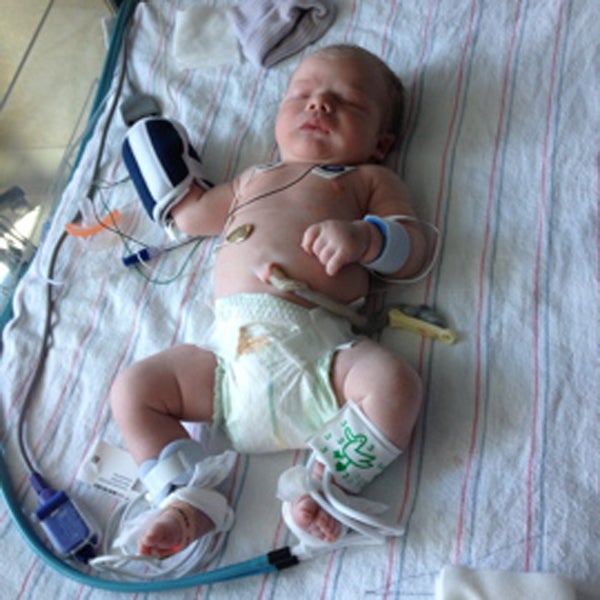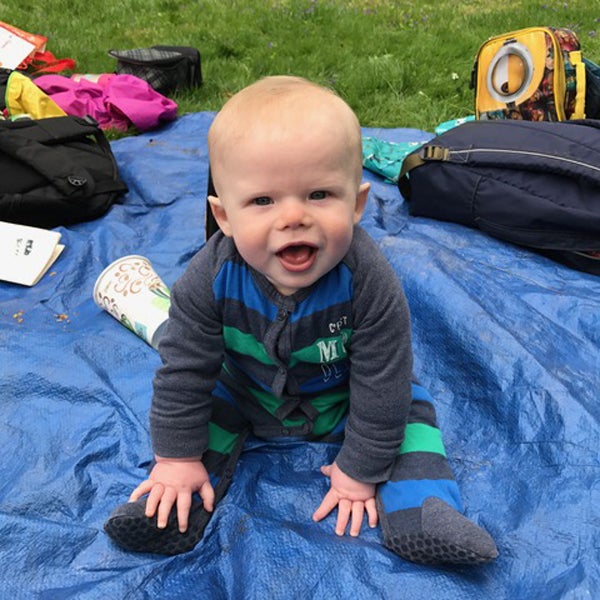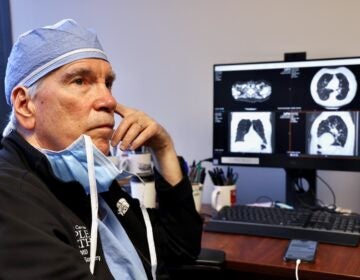A newborn boy with a genetic heart condition; a father’s joy and dread
On Aug. 10, 2016, less than one month before my wife Kate was due to give birth to our second child, she and I received news that would change our lives forever.
Listen
Amos Ben-Yaacov, 1 day old (Shai Ben-Yaacov/WHYY)
On Aug. 10, 2016, less than one month before my wife Kate was due to give birth to our second child, she and I received news that would change our lives forever.
A routine ultrasound had revealed that our unborn baby had a rare congenital heart condition called tetralogy of Fallot and would require surgery at some point during the first year of life. Furthermore, the baby’s anatomy suggested the heart condition might be just one symptom of a chromosome abnormality that would affect the child physically, behaviorally, and cognitively.
We were in shock.
On Aug. 30, after a hasty transition to the special delivery unit at Children’s Hospital of Philadelphia, Kate gave birth to a beautiful and seemingly perfect 7 lb., 15 oz., boy. We didn’t get to spend much time with him at first, because he was whisked away to an adjacent room and checked for respiration, oxygen saturation, and countless other –ations.
He was then taken to the cardiac intensive care unit. After a brief monitoring period when doctors determined he was breathing well, my wife and I got to go visit our son.
He was pink and fat, with a tuft of wispy blond hair and the furrowed brow passed down from my father-in-law (he’s the spitting image of him). I’m not too modest to say he was a beautiful baby with porcelain features and probing blue eyes. Even with an oxygen tube up his nose and hoses measuring his vitals, he looked healthy and peaceful. We named him Amos.
Two days after he was born, genetic testing confirmed that Amos did indeed have the chromosome disorder suspected by doctors. The condition, called 22q11.2 Deletion Syndrome, is both terrifying and fascinating. I could write a book with all I’ve learned about 22q, as it’s widely known, but I’ll instead direct readers to the International 22q Foundation for all the information anyone could ever want about the syndrome.
In short, 22q is a genetic condition that usually occurs randomly. It can cause more than 180 different symptoms, from club feet to cleft palate to ADHD. No two people manifest in the same way, and most will end up with only 10 or 20 symptoms from that daunting list. People with 22q can look, appear, and behave perfectly normally, or they may be more severely affected and need more intensive care.
The single most common symptom for kids with 22q is congenital heart disease, and one of the most common forms in that group is tetralogy of Fallot. If that condition sounds familiar, it might be because you heard Jimmy Kimmel talking about it earlier this week. His son Billy was born with tetralogy of Fallot last month.
A little bit about tetralogy of Fallot: It’s a complex heart condition involving a hole between the two lower chambers of the heart, or ventricles. This means the oxygen-rich blood coming from the lungs mixes with the oxygen-poor blood pumped back into the heart from the rest of the body. The result is that kids with tetralogy of Fallot get less oxygen to their organs than they should, though how much less depends on the specifics of their condition. Some turn blue from this lack of oxygen.
In the case of Jimmy Kimmel’s son, the condition was complicated by something called pulmonary atresia. This means the artery that is supposed to take blood from the heart to the lungs was completely blocked. It’s an emergency situation requiring surgery hours after birth. Fortunately for us, Amos didn’t have pulmonary atresia.
Unless you’ve had a child born with a life-threatening condition, it’s difficult to describe the emotions Jimmy and I have experienced. It’s a strange mixture of joy and dread — a swelling of the heart coexisting with a sinking feeling in the pit of your stomach. It is overwhelming in its intensity. It takes you from the highest of highs to the lowest of lows and back again in seconds. It’s definitely like nothing else I’ve ever felt.
The early months parenting Amos were tense but happy ones. After five days of monitoring at CHOP, Amos came home and repeatedly defied expectations. He was able to eat and breathe completely on his own (not always possible for kids with his condition), and while he was slow to grow due to his heart working twice as hard as it should, he did grow and do all of the regular baby things he was supposed to do. He met frequently with his cardiologist, who after three months decided it was time for Amos’s surgery to patch the hole, called a ventricular septal defect, or VSD.
Sending an infant in for major surgery is something I wish no parent had to go through. There’s no getting around it: It sucks. As much as doctors try to reassure you, it’s very, very, very hard to send them off to the OR. But what choice did we have?
At about 8 a.m. on Dec. 5, 2016, Kate and I kissed Amos on the forehead, and the doctors wheeled him away. We spent the next four hours in a waiting area, trying in vain not to worry. A kind and attentive nurse came in each hour with updates about where they were with the surgery as I fidgeted and tried to keep calm. Honestly, I can’t remember some stretches of those four hours, but I do remember reuniting with Amos early that afternoon.
When we came into his hospital room, Amos was awake and crying a cranky, hoarse cry as he tried to rip out the tube forcing oxygen up his nose. He had several tubes coming out of his chest and arms, and a large white patch over his sternum. I remember thinking that, while he looked groggy and grumpy, he didn’t look ill. In fact, his color, which had always been on the pale side (even for a kid with Irish and Russian Jewish ancestry), was becoming distinctly rosier. I kissed my son on the forehead once again.
Amos continued to impress doctors, springing free of CHOP in five days once again. He started to grow much faster after that, and while he’s still on the small side, his growth curve has been steep.
Now, at eight months, Amos is acting just like any normal baby. He’s meeting all of his developmental milestones, and other than a few minor physical issues, he’s pretty healthy. And still adorable.
 Amos Ben-Yaacov, 8 months (Shai Ben-Yaacov/WHYY)
Amos Ben-Yaacov, 8 months (Shai Ben-Yaacov/WHYY)
His mother and I know there probably will be challenges to face in Amos’s future, but we can’t imagine life without him. And day by day, that feeling of dread in the pit of my stomach is fading, replaced by an even greater swelling of pride and joy in my own heart as Amos’s sunny, cheerful personality emerges.
I know it will be the same for Jimmy.
WHYY is your source for fact-based, in-depth journalism and information. As a nonprofit organization, we rely on financial support from readers like you. Please give today.




